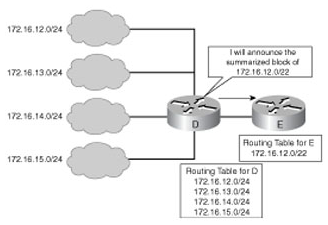Route Summarization is basically the act or process of reducing the overall number of routes in a given routing table. In large networks with thousands or even hundreds of thousands of routes the burden on the Routers CPU can become quite significant. With most Routers today this is not so much of a problem, but the act of summarization or supernetting is still a valid solution to the problem.
Basically what Summarization does is group subnets into smaller subnet that the Router can advertise or reference in order to send or receive packets to the correct destination. When this feature is enable on a Router running a routing protocol its usually referred to as Auto Summary.

Lets take the following simple example as shown in the diagram above and summarize the the 4 networks into one single network or subnet that the Router can advertise.
Networks
- 172.16.12.0/24 or 172.17.12.0 255.255.255.0
- 172.16.13.0/24 or 172.17.13.0 255.255.255.0
- 172.16.14.0/24 or 172.17.14.0 255.255.255.0
- 172.16.15.0/24 or 172.17.15.0 255.255.255.0
The Binary Approach
The fist thing we have to do is convert the networks to binary. This way we can see right when the difference begins. However converting to binary takes a long time and if your taking an Exam this will more then likely kill your chances of passing. Never the less lets take a look. We need to focus on the pattern that matches, and in this case it ends on the third octet right after the first two high order bits.
01010110.00010000.00001100.00000000
01010110.00010000.00001101.00000000
01010110.00010000.00001110.00000000
01010110.00010000.00001111.00000000
The common pattern match in the group was 00001100 or 12, and if we add 2 more bits to the mask we end up with 11111111.11111111.1100000.00000000.
Out of the 4 networks 172.16.12.0 was the smallest. So if we look a the pattern and count the number of bits from left to right we have a total of 22 that we can use for the mask.
Therefore the summarized route would be 172.16.12.0/22 or 172.17.12.0 255.255.192.0
The Hybrid Approach
There is a much simpler way to calculate the summarized networks without converting everything to binary. At a glance we can see that the all 4 networks share the same pattern of 172.16.0.0 with a corresponding mask value of 255.255.0.0. At this point we are half 1/2 way there. Now all we need to do is figure out where the pattern differs in the 3 octet.
172.16.0.0/16 or 172.16.0.0 255.255.0.0
172.16.[ 12 ].0 convert 12 to binary 00001100
172.16.[ 13 ].0 convert 13 to binary 00001101
172.16.[ 14 ].0 convert 14 to binary 00001110
172.16.[ 15 ].0 convert 15 to binary 00001111
The common pattern match from the group above was 00001100 or 12. So if we add the 2 bits to the mask as we did above we end up with 255.255.192.0 or a /22. Lets take a few steps further to clarify.
The Summarized Mask = 8 + 8 + 6 = 22
The Summarized Mask = 172.16.12.0/22 or 172.16.12.0 255.255.192.0
I hope you found this post on Route Summerization helpful and informative. Be sure to let me know what you think by leaving suggestions, and feedback in the comments section below. You can find out more about these and other articles be checking out recent posts and archives. To learn more about me be sure to check out the About page. And as always thanks again for visiting The Packet.
